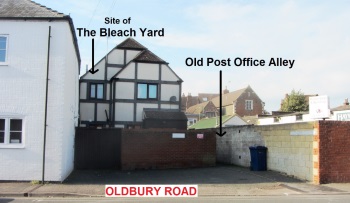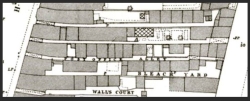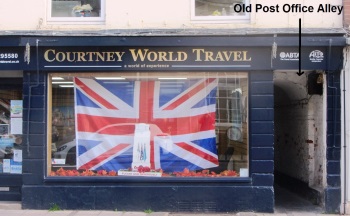Old Post Office Alley
to Expand
In about 1870 the Post Office at 127 High Street closed and moved to Church Street. The alley alongside it became Old Post Office Alley. Confusingly, the lane alongside the Church Street premises is Post Office Lane. The Post Office itself has moved three times more since then
Writing in 1905, John Rogers said that in its heyday, maybe 60 years earlier, the alley was filled with stocking frames; machines for knitting stockings. There may have been up to a dozen cottages and Mr Key, a hosier, had a frame-shop at the Oldbury end of the alley. It had this in common with many alleys where people lived at barely subsistence levels in appalling squalor. The frame shop had gone by 1868, replaced by a ‘capital brick-built cottage’, rented to Caleb Malpas at £5 4s per annum.
to Expand
The demise of stocking knitting in the middle of the nineteenth century saw a mixed population in the alley. The standard of the cottages meant low rents and ‘less respectable’ tenants. For an alley with a maximum of eleven cottages the variety and frequency of magistrate’s court appearances is surprising. If John Moore had spent his childhood looking out over this alley rather than Double Alley he’d have seen just as much to speculate and write about! Offences committed by people who lived there were generally minor; obscene language, drunk and disorderly or fighting. There were, though, cases of school non-attendance, child neglect, child cruelty and the inevitable overcrowding. Fredrick Hook was given hard labour for wife beating and attacking a constable with a chair leg. Sophia Hawker was jailed for three months for keeping a brothel, though the problem that brought her to court was that her staff were stealing from their clients’ wallets.
In 1913, William Green, drover, was convicted of obstructing the highway with a herd of cows. The complainant was the Deputy Inspector-General of the Indian police, who claimed that he was held up for up to three minutes. He was fined half a crown, but the prosecuting solicitor must have had a great deal of sympathy because he very publicly paid the fine! William Green was no stranger to the court, though, and had probably contributed his own misfortune because of a quick temper. His wife was from the same mould and seems to have picked fights with half the other women in the alley. They were probably not good neighbours.

The alley was notoriously insanitary. In 1879 there was only one convenience for the eleven houses there and in 1892 the Council were concerned that Cholera might break out again, but did little about it beyond worrying. The house numbers decreased slowly as orders were obtained to have dangerous ones pulled down. In 1938, with council houses being built elsewhere, clearance orders were obtained for eight cottages as well as all the cottages in the adjacent Bleach Yard. The war delayed demolition, but not for long. In 1950, number 5, the last, was condemned despite Councillor Bannister describing it as “a palace compared with some places in Tewkesbury” and the last resident left the alley.
With no buildings left, Hayward’s took the opportunity to extend the yard behind their shop to give space for business expansion. A concrete block wall took the place of what were cottage fronts. In the 1990s, cottages re-appeared; built on the site of the old Bleach Yard cottages, but opening on to Old Post Office Alley. Thus the old pattern of development was changed and the houses are not behind the front house. They are, though, an example of how alleys can have a new life with practical modern houses in keeping with their setting.




Comments